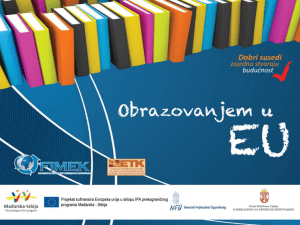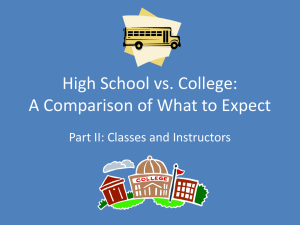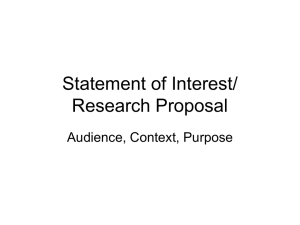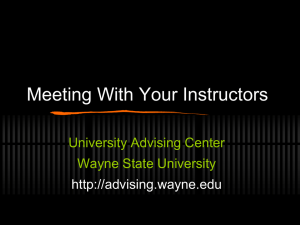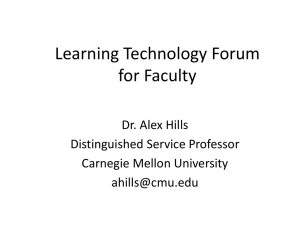Against the Instructor/Course Evaluation form
advertisement
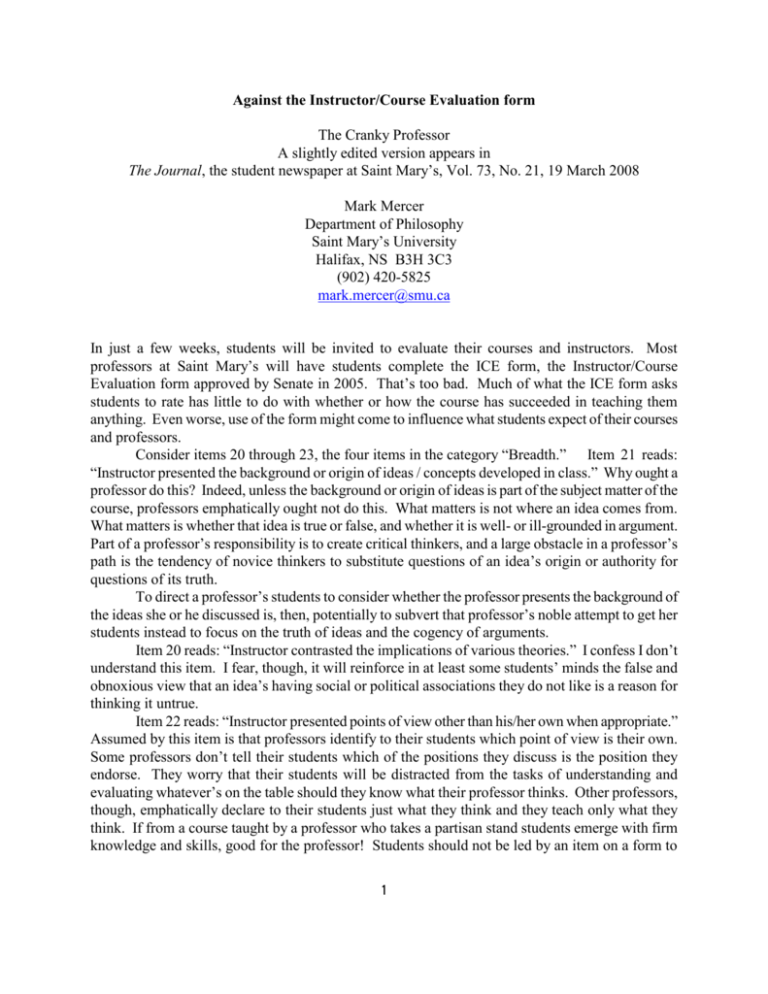
Against the Instructor/Course Evaluation form The Cranky Professor A slightly edited version appears in The Journal, the student newspaper at Saint Mary’s, Vol. 73, No. 21, 19 March 2008 Mark Mercer Department of Philosophy Saint Mary’s University Halifax, NS B3H 3C3 (902) 420-5825 mark.mercer@smu.ca In just a few weeks, students will be invited to evaluate their courses and instructors. Most professors at Saint Mary’s will have students complete the ICE form, the Instructor/Course Evaluation form approved by Senate in 2005. That’s too bad. Much of what the ICE form asks students to rate has little to do with whether or how the course has succeeded in teaching them anything. Even worse, use of the form might come to influence what students expect of their courses and professors. Consider items 20 through 23, the four items in the category “Breadth.” Item 21 reads: “Instructor presented the background or origin of ideas / concepts developed in class.” Why ought a professor do this? Indeed, unless the background or origin of ideas is part of the subject matter of the course, professors emphatically ought not do this. What matters is not where an idea comes from. What matters is whether that idea is true or false, and whether it is well- or ill-grounded in argument. Part of a professor’s responsibility is to create critical thinkers, and a large obstacle in a professor’s path is the tendency of novice thinkers to substitute questions of an idea’s origin or authority for questions of its truth. To direct a professor’s students to consider whether the professor presents the background of the ideas she or he discussed is, then, potentially to subvert that professor’s noble attempt to get her students instead to focus on the truth of ideas and the cogency of arguments. Item 20 reads: “Instructor contrasted the implications of various theories.” I confess I don’t understand this item. I fear, though, it will reinforce in at least some students’ minds the false and obnoxious view that an idea’s having social or political associations they do not like is a reason for thinking it untrue. Item 22 reads: “Instructor presented points of view other than his/her own when appropriate.” Assumed by this item is that professors identify to their students which point of view is their own. Some professors don’t tell their students which of the positions they discuss is the position they endorse. They worry that their students will be distracted from the tasks of understanding and evaluating whatever’s on the table should they know what their professor thinks. Other professors, though, emphatically declare to their students just what they think and they teach only what they think. If from a course taught by a professor who takes a partisan stand students emerge with firm knowledge and skills, good for the professor! Students should not be led by an item on a form to 1 think that this professor has wronged them. Item 23 reads: “Instructor adequately discussed current developments in the field.” This item presupposes that current developments in the field always merit discussion. Sometimes current developments don’t merit discussion. Class time ought not be wasted discussing what doesn’t merit discussion. Though most dangerous are items 20 through 23, some other items on the ICE form are also potentially harmful. See, especially, items in the “Individual Rapport,” “Enthusiasm,” and “Group Interaction” categories. One might here remind me that professors don’t have to use the ICE form. They can use whatever form or system they like. Professors don’t have to solicit student scores or comments at all, if they don’t want to. So what, then, is the problem?, one might ask. Those who don’t like the ICE form don’t have to use it. My point, though, is not just that the ICE form isn’t useful to all professors. The problem is that the teaching philosophy embedded in the ICE form is a bad teaching philosophy. It is the philosophy according to which teaching consists in making students aware of a smorgasbord of ideas from which they may pick and choose—from which they may pick and choose uncritically. That’s the idea behind items 20 through 23. Really, though, what we as professors ought to be doing is helping our students to acquire the ability to investigate ideas evaluatively, argumentatively. The ICE form not only is useless to a professor who teaches hoping to create competent intellectuals, but in fact subverts her efforts. The ICE form carries the imprimatur of Saint Mary’s University. Students, then, may well come to expect that their professors will teach in a manner consistent with the items on that form. There’s the danger. The form promotes the misguided philosophy of teaching on which it is based as the official teaching philosophy of our university. I propose that the university remove its imprimatur from the ICE form. Saint Mary’s University ought have no official course or professor evaluation form. I would also urge individual professors to ask seriously whether the ICE form is right for them. Those who judge that it isn’t, as I’m sure many will, should use a different form. The argument that the university ought have no official form strikes me as entirely cogent—but that an argument is cogent, I realize, rarely motivates administrators. Probably the university won’t remove its imprimatur from the ICE until it notices that few professors are using it. —30— 2
